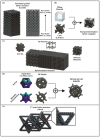Architected Materials for Additive Manufacturing: A Comprehensive Review
- PMID: 36079300
- PMCID: PMC9456607
- DOI: 10.3390/ma15175919
Architected Materials for Additive Manufacturing: A Comprehensive Review
Abstract
One of the main advantages of Additive Manufacturing (AM) is the ability to produce topologically optimized parts with high geometric complexity. In this context, a plethora of architected materials was investigated and utilized in order to optimize the 3D design of existing parts, reducing their mass, topology-controlling their mechanical response, and adding remarkable physical properties, such as high porosity and high surface area to volume ratio. Thus, the current re-view has been focused on providing the definition of architected materials and explaining their main physical properties. Furthermore, an up-to-date classification of cellular materials is presented containing all types of lattice structures. In addition, this research summarized the developed methods that enhance the mechanical performance of architected materials. Then, the effective mechanical behavior of the architected materials was investigated and compared through the existing literature. Moreover, commercial applications and potential uses of the architected materials are presented in various industries, such as the aeronautical, automotive, biomechanical, etc. The objectives of this comprehensive review are to provide a detailed map of the existing architected materials and their mechanical behavior, explore innovative techniques for improving them and highlight the comprehensive advantages of topology optimization in industrial applications utilizing additive manufacturing and novel architected materials.
Keywords: additive manufacturing; architected materials; lattice structures; scaling laws; topology optimization.
Conflict of interest statement
The authors declare no conflict of interest.
Figures




Similar articles
-
In Situ Investigation of Tensile Response for Inconel 718 Micro-Architected Materials Fabricated by Selective Laser Melting.Materials (Basel). 2024 Sep 9;17(17):4433. doi: 10.3390/ma17174433. Materials (Basel). 2024. PMID: 39274822 Free PMC article.
-
Development of biodegradable customized tibial scaffold with advanced architected materials utilizing additive manufacturing.J Mech Behav Biomed Mater. 2023 May;141:105796. doi: 10.1016/j.jmbbm.2023.105796. Epub 2023 Mar 21. J Mech Behav Biomed Mater. 2023. PMID: 36965217
-
Optimally-Tailored Spinodal Architected Materials for Multiscale Design and Manufacturing.Adv Mater. 2022 Jul;34(26):e2109304. doi: 10.1002/adma.202109304. Epub 2022 Apr 27. Adv Mater. 2022. PMID: 35297113
-
Responsive materials architected in space and time.Nat Rev Mater. 2022;7(9):683-701. doi: 10.1038/s41578-022-00450-z. Epub 2022 Jun 20. Nat Rev Mater. 2022. PMID: 35757102 Free PMC article. Review.
-
Multi-Physical Lattice Metamaterials Enabled by Additive Manufacturing: Design Principles, Interaction Mechanisms, and Multifunctional Applications.Adv Sci (Weinh). 2025 Feb;12(8):e2405835. doi: 10.1002/advs.202405835. Epub 2025 Jan 20. Adv Sci (Weinh). 2025. PMID: 39834122 Free PMC article. Review.
Cited by
-
Supportless Lattice Structure for Additive Manufacturing of Functional Products and the Evaluation of Its Mechanical Property at Variable Strain Rates.Materials (Basel). 2022 Nov 10;15(22):7954. doi: 10.3390/ma15227954. Materials (Basel). 2022. PMID: 36431440 Free PMC article.
-
The Influence of 3D Printing Core Construction (Binder Jetting) on the Amount of Generated Gases in the Environmental and Technological Aspect.Materials (Basel). 2023 Aug 8;16(16):5507. doi: 10.3390/ma16165507. Materials (Basel). 2023. PMID: 37629797 Free PMC article.
-
Design of Shape Forming Elements for Architected Composites via Bayesian Optimization and Genetic Algorithms: A Concept Evaluation.Materials (Basel). 2024 Oct 31;17(21):5339. doi: 10.3390/ma17215339. Materials (Basel). 2024. PMID: 39517609 Free PMC article.
-
Numerical Simulation of Compressive Testing of Sandwich Structures with Novel Triply Periodic Minimal Surface Cores.Materials (Basel). 2025 Jan 9;18(2):260. doi: 10.3390/ma18020260. Materials (Basel). 2025. PMID: 39859731 Free PMC article.
-
Parametric Design and Mechanical Characterization of a Selective Laser Sintering Additively Manufactured Biomimetic Ribbed Dome Inspired by the Chorion of Lepidopteran Eggs.Biomimetics (Basel). 2024 Dec 24;10(1):1. doi: 10.3390/biomimetics10010001. Biomimetics (Basel). 2024. PMID: 39851717 Free PMC article.
References
-
- Bendsoe M.P., Sigmund O. Topology Optimization: Theory, Methods, and Applications. 2nd ed. Springer; Berlin/Heidelberg, Germany: 2003. - DOI
-
- Navez T., Schmidt M.P., Sigmund O., Pedersen C.B.W. Topology optimization guided by a geometrical pattern library. Struct. Multidisc. Optim. 2022;65:108. doi: 10.1007/s00158-022-03197-x. - DOI
-
- Gebisa A.W., Lemu H.G. A case study on topology optimized design for additive Manufacturing. IOP Conf. Ser. Mater. Sci. Eng. 2017;276:12026. doi: 10.1088/1757-899X/276/1/012026. - DOI
-
- Li C., Kim I.Y., Jeswiet J. Conceptual and detailed design of an automotive engine cradle by using topology, shape, and size optimization. J. Struct. Multidiscip. Optim. 2015;51:547–564. doi: 10.1007/s00158-014-1151-6. - DOI
-
- Chen Y., Wang Q., Wang C., Gong P., Shi Y., Yu Y., Liu Z. Topology Optimization Design and Experimental Research of a 3D-Printed Metal Aerospace Bracket Considering Fatigue Performance. Appl. Sci. 2021;11:6671. doi: 10.3390/app11156671. - DOI
Publication types
LinkOut - more resources
Full Text Sources
Other Literature Sources

